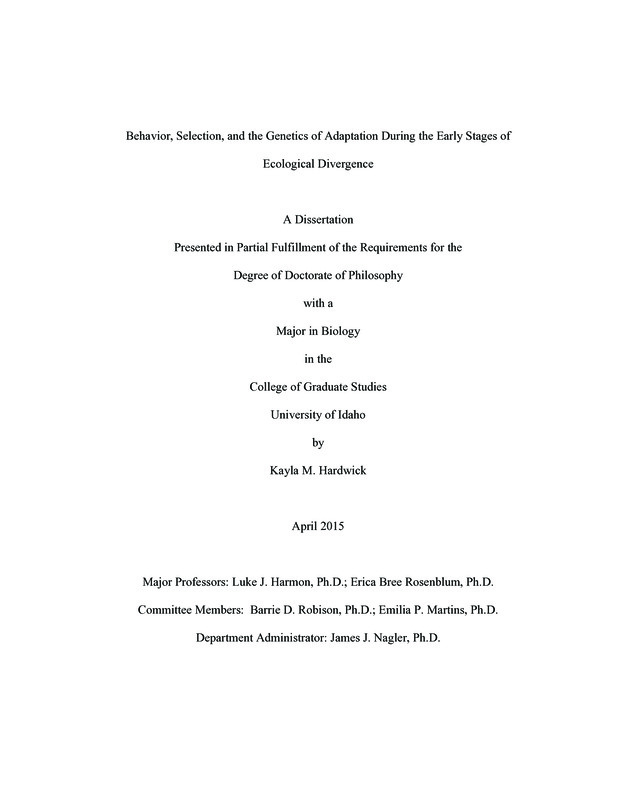Behavior, Selection, and the Genetics of Adaptation During the Early Stages of Ecological Divergence
Hardwick, Kayla Michelle. (2015). Behavior, Selection, and the Genetics of Adaptation During the Early Stages of Ecological Divergence. Theses and Dissertations Collection, University of Idaho Library Digital Collections. https://www.lib.uidaho.edu/digital/etd/items/hardwick_idaho_0089e_10545.html
- Title:
- Behavior, Selection, and the Genetics of Adaptation During the Early Stages of Ecological Divergence
- Author:
- Hardwick, Kayla Michelle
- Date:
- 2015
- Program:
- Biology
- Subject Category:
- Biology
- Abstract:
-
Adaptive divergence is a complex process, the outcome of which is often difficult to predict. The ecological speciation continuum has recently emerged as a framework for understanding the dynamic nature of adaptive divergence and identifying factors that facilitate or inhibit the evolution of reproductive isolation. However, the relative contributions of different factors to progress along the speciation continuum during real-world instances of adaptive divergence remain poorly understood in most systems
The White Sands system provides an opportunity to investigate how different factors influence position along the speciation continuum. White Sands, a gypsum dune field that formed recently within the Chihuahuan desert, represents a striking contrast to the surrounding desert scrubland. Three lizard species have colonized the novel White Sands environment: the Eastern Fence Lizard (Sceloporus undulatus), the Little Striped Whiptail (Aspidoscelis inornata), and the Lesser Earless Lizard (Holbrookia maculata). In all three species, populations on and off White Sands have diverged in a number of phenotypic characteristics and are likely in the incipient stages of ecological speciation.
My dissertation research focuses on how factors such as behavior, selection, and the genetics of adaptation affect the evolution of reproductive isolation during the early stages of ecological speciation, focusing primarily on the White Sands system. In Chapter II I examined mate preference between ecologically distinct populations of S. undulatus in White Sands, dark soils, and lava flow habitats and found evidence for asymmetrical reproductive isolation. In Chapter III I investigated selection on color in H. maculata, and I found that space, time, and sex influence the dynamics of predation on lizards in White Sands. In Chapter IV I used computer simulations to demonstrate that reproductive isolation evolves more rapidly during ecological speciation when adaptation occurs from standing genetic variation compared with new mutation. Finally, in Chapter V I explored the relative roles of ecological barriers and geographic distance in generating genetic divergence between populations. I found that White Sands acts as a barrier to gene flow in both species, and that the magnitude of the effect of White Sands on genetic divergence is most likely greater in S. undulatus than A. inornata.
- Description:
- doctoral, Ph.D., Biology -- University of Idaho - College of Graduate Studies, 2015
- Major Professor:
- Harmon, Luke J; Rosenblum, Erica B
- Committee:
- Robison, Barrie D; Martins, Emilia P
- Defense Date:
- 2015
- Identifier:
- Hardwick_idaho_0089E_10545
- Type:
- Text
- Format Original:
- Format:
- application/pdf
- Rights:
- In Copyright - Educational Use Permitted. For more information, please contact University of Idaho Library Special Collections and Archives Department at libspec@uidaho.edu.
- Standardized Rights:
- http://rightsstatements.org/vocab/InC-EDU/1.0/

